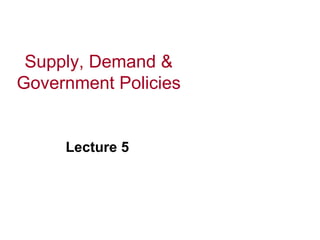Supply, Demand & Government Policies
- 1. Supply, Demand & Government Policies Lecture 5
- 2. ŌĆó In a free market system, market forces establish equilibrium prices and exchange quantities. ŌĆó One of the roles of economists is to develop theories to assist in the development of policies.
- 3. Controls on Prices ŌĆó Buyers always want lower prices, while sellers want higher prices. ŌĆó Thus, interests of these two groups conflict. ŌĆó Controls on prices are usually enacted when policymakers believe the market price is unfair to buyers or sellers. ŌĆó For this government creates price ceilings and price floors.
- 4. Controls on Prices ContŌĆ” ŌĆó Price Ceiling: ŌĆō A legal ŌĆ£maximumŌĆØ on the price at which a good can be sold. ŌĆó Price Floor: ŌĆō A legal ŌĆ£minimumŌĆØ on the price at which a good can be sold.
- 5. Controls on Prices ContŌĆ” How Price Ceilings Affect Market Outcomes: ŌĆó When govt. imposes price ceiling, following two outcomes are possible: 1. If price is set above the equilibrium price, price ceiling is not binding . ŌĆó Price ceiling has no effect on the price or quantity sold .
- 6. Price Ceiling that is NOT BINDING Price Supply P2 Price Ceiling P1 Equilibrium Price Demand 0 Q Quantity Equilibrium Quantity
- 7. Controls on Prices ContŌĆ” How Price Ceilings Affect Market Outcomes (Cont.): 2. If price is set below the equilibrium price, price ceiling is a binding constraint. ŌĆó The forces of demand and supply move price towards equilibrium price. ŌĆó But when market price hits the ceiling, it can rise no further. ŌĆó Thus, market price equals price ceiling. ŌĆó At this price, quantity demanded exceeds quantity supplied, creating shortage for the good.
- 8. Price Ceiling that is BINDING Price Supply Equilibrium Price P2 P1 Price Shortage Ceiling Demand 0 Q1 Q2 Quantity Quantity Quantity Supplied Demanded
- 9. Controls on Prices ContŌĆ” How Price Ceilings Affect Market Outcomes (Cont.): ŌĆó Therefore, when government imposes a binding price ceiling on a market, shortage of the good arises
- 10. Controls on Prices ContŌĆ” How Price Floors Affect Market Outcomes: ŌĆó When govt. imposes price floor, following two outcomes are possible: 1. If price is set below the equilibrium price, price floor is not binding . ŌĆó Price floor has no effect on the price or quantity sold .
- 11. Price Floor that is NOT BINDING Price Supply Equilibrium Price P2 Price Floor P1 Demand 0 Q Quantity Equilibrium Quantity
- 12. Controls on Prices ContŌĆ” How Price Floors Affect Market Outcomes (Cont.): 2. If price is set above the equilibrium price, price floor is a binding constraint. ŌĆó The forces of demand and supply move price towards equilibrium price. ŌĆó But when market price hits the floor, it can fall no further. ŌĆó Thus, market price equals price floor. ŌĆó At this price, quantity supplied exceeds quantity demanded, causing surplus for the good.
- 13. Price Floor that is BINDING Price Supply Surplus P2 Price Floor P1 Equilibrium Price Demand 0 Q1 Q2 Quantity Quantity Quantity Demanded Supplied
- 14. Taxes ŌĆó Governments use taxes to raise revenue for public projects, such as for: ŌĆō Roads ŌĆō Schools ŌĆō National defense ŌĆó Taxes affect market activity. ŌĆó When a good is taxed, the quantity sold is smaller.
- 15. Taxes ContŌĆ” Important Question ŌĆó When govt. levies tax on a good, who bears the burden of the tax? Buyers Or Sellers
- 16. Taxes ContŌĆ” ŌĆó Economists use the term tax incidence to refer to the distribution of tax burden. ŌĆó ŌĆ£Tax incidence is the manner in which the burden of a tax is shared among participants in a marketŌĆØ.
- 17. Taxes ContŌĆ” ŌĆó Taxes result in a change in market equilibrium. ŌĆó Buyers pay more and sellers receive less, regardless of whom the tax is levied on.
- 18. Taxes ContŌĆ” ŌĆó What is the impact of tax? ŌĆō Taxes discourage market activity. ŌĆō When a good is taxed, the quantity sold is smaller. ŌĆō Buyers and sellers share the tax burden.

















